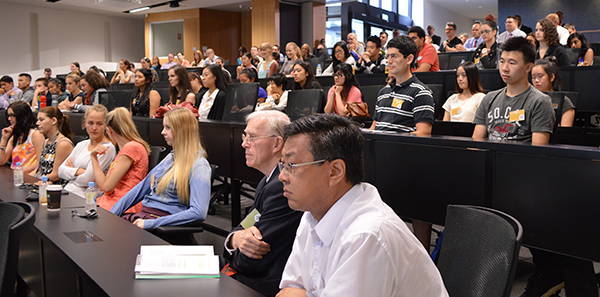1:30min

Deakin University optometry orientation day, March 2014 Photo: Optometry Australia
______________________________
By Rhiannon Riches
Assistant Editor
New accreditation standards for optometry programs allow greater flexibility in the ways compliance with the standards can be demonstrated.
The Optometry Council of Australia and New Zealand (OCANZ) has released new Accreditation Standards and Evidence Guide for Entry-Level Optometry Programs, following approval from the Optometry Board of Australia (OBA).
They will take effect on 1 January 2017.
OCANZ executive officer Sian Lewis said the new standards were the result of a lengthy consultation process.
‘The project took 12 months, taking into account all components and all stakeholders,’ she said.
Ms Lewis said the new education accreditation standards were more flexible and more focused on the outcomes for graduates than on particular structures or ways and means of course delivery.
‘Providers still have to meet the standard, but we have removed the rigid process requirements. For example, previously we specified that there must be certain committees in place. Now, we still require robust academic governance but without saying what form that must take,’ she said.
‘Previously we specified what prior knowledge of maths and chemistry was required for entry to the program. Now, we still require “admission requirements which are robust, equitable and transparent” but do not specify in detail what entry criteria is required. Each university must set its own admission requirements and demonstrate how it meets the standards.’
All OCANZ-accredited entry-level programs of study will be assessed against the new standards in 2017.
The new standards comprise five domains: public safety; academic governance and quality assurance; program of study (including design, delivery, and resources); the student experience; and assessment.
A ‘standard statement’ conveys the key purpose of each domain, and each ‘standard statement’ is supported by criteria and guidelines that set out what is expected of an OCANZ-accredited program to meet each standard statement.
Dr Patricia Kiely, Optometry Australia standards and research adviser, said Optometry Australia took part in the consultation process with OCANZ.
‘The endorsement and use of Optometry Australia’s competency standards in the accreditation process demonstrates the important role that Optometry Australia plays in developing these standards,’ Dr Kiely said.
OCANZ Accreditation Standards and Evidence Guide for Entry-Level Optometry Programs
Optometry Australia Entry-level Competency Standards for Optometry 2014